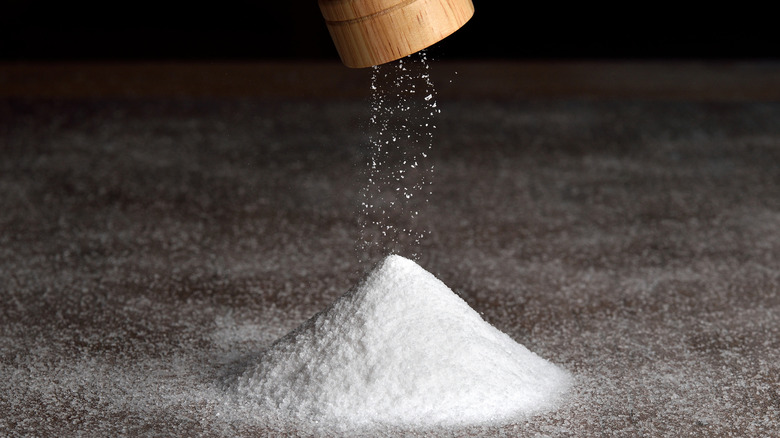Rachael Ray's Easy Tip For Maximizing The Flavor Of Every Dish
If you grew up watching "30-Minute Meals," Rachael Ray's vintage appliances, high energy, and genius technique known as the "garbage bowl" (per Food52) might spark some childhood nostalgia. The way she maneuvered around the kitchen let you know she meant business, and whatever Rachael Ray said, you trusted. The star transformed the industry, according to ABC News, having written 16 cookbooks (and counting), is now hosting her own talk show and has even created a line of cookware, knives, furniture, olive oil and dog food. Ray doesn't seem to be slowing down anytime soon, and after a recent TikTok video she posted, we're grateful.
We've all been there. The meal you just spent hours cooking has not-so-good flavor, falling flat to what you were salivating for. Naturally, you reach for the table salt, but Ray claims you should've been reaching for it far before now. "Every time you cook, every layer that you use needs to be seasoned along the way. Not over-seasoned, but seasoned. Everything you touch should have flavor as you go," she explained to TikTok users. This 20-second video has 44,000 likes and over 500 comments (as of this writing), most of which include users expressing how mind blown they are. So what exactly is a layer, and how do we season like Rachael?
Layers of flavor
When Rachael Ray talks about a "layer," she is essentially talking about a step, and every dish you create has a step-by-step process. It's important to know at which step to add salt, but first it's good to recognize, as Tablespoon.com points out, the ingredients that already have plenty of salt present. Sea salt, kosher salt, and iodized salt are typically what you think of, but ingredients like Worcestershire, bacon, capers, anchovies, soy sauce, fish sauce, miso and certain cheeses can replace salt in dishes depending on their different levels of sodium. When adding any of those ingredients to your dish, be sure to taste before adjusting.
While you want to take Ray's advice and season your dish as you go, you don't want to sprinkle salt on your iceberg lettuce. Let's take a burger for instance: The first step is to season the meat and divide into patties. You're probably not going to season the toppings like pickles, lettuce, mayo or tomatoes, but you CAN add extra flavor by buttering and salting the buns to toast before serving. Other dishes like pastas, soups, and stews use several steps with different techniques that make it more natural to throw some seasonings in there as you go, such as salting water for pasta or veggies — that's a layer. Or roasting tomatoes before you throw 'em in the blender for a sauce. You'll want to coat them in olive oil and season with salt and pepper before popping them in the oven. That's also a layer!
Why salt? What about other flavors?
According to international market Jungle Jim's, salt is crucial to our enjoyment of food. Salt masks unpleasant bitter tastes and enhances the natural flavors in whatever you're cooking. Whether you pinch it with your fingers, sprinkle it from up high, toss it like a frisbee, or let it run off your elbows like Salt Bae, Rachael Ray emphasizes that kitchens should have copious amounts of it. It won't go bad, it will always be in style, and different kinds of salt are good for different things. Iodized salt is best for baking or pouring into salt shakers for the table, kosher salt is best for everyday cooking, and coarse sea salt is best on top of finished dishes for texture and added flavor.
While salt is the star, other spices are always welcome. "Flavor can come from aromatics and herbs," says Ray. When you get your feet wet in the kitchen, you start to understand which spices pair well together, and which absolutely do not. Staples like black pepper, garlic powder, paprika and dried herbs are a safe start and will add a world of difference to your finished product.
Some of the top-notch flavors in fancy restaurants are produced by layering seasoning, a technique that chefs have practiced for years and years, and which Rachael Ray reminds us to carry on in our own kitchens. While it may not come as natural at first, and you might burn your tongue a few times on taste tests, a little change in routine could yield really yummy results.


